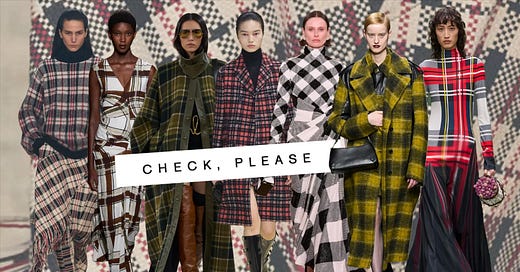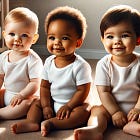Mitigating Post-Pandemic Style Trends With A Timeless Aesthetic, Part 1
Sandy Dumont had "The Image Architect" registered with the US Patent and Trademark Office for decades, and for good reason. Using architectural principles of color and line was her specialty.
Hi, it’s Tatyana!
I hope you’re having a lovely start to the month. It has been moderately hot here in the Inland Northwest, with smoke from fires in the region creating slight air-quality problems. The article for this week was getting so long, that I had to break it down into multiple parts. In this 2-part series, we will have an overview of current trends, review style rules for “architecting” a timeless and elegant aesthetic, and then evaluate those trends for what they do to the face and body. You will see some definite do’s and don’ts emerge and strengthen your “style literacy”. Be sure to read all the way to the end to find the Tip of The Day.
Note: This letter has quite a bit of content and some email providers might have a cut-off. In this case, please click “View Entire Message” when you get to the cut-off point to read the rest of it on the site. Thanks and enjoy!
Light Loves Color is running a limited time SALE on subscriptions! For the rest of this week, lock your rate in at $5.99/mo to begin receiving full access. Style guides, monthly webinars, online courses, and discounts on 1-on-1 sessions are in the works for paid members. If you’ve been on the fence about signing up, this is the time to do it. The price will go back up this Friday at 3pm Pacific time.
In the ever-evolving world of fashion, staying ahead of the trends while maintaining a personal style that truly represents you can be quite the challenge. Post-pandemic, our style choices have shifted dramatically towards comfort and casualness, sometimes at the expense of polish and sophistication.
This year, fashion seems to be all about mixing the old with the new, combining comfort with style, and expressing individuality. But if we look at the timeless style principles of The Image Architect, we can navigate the ever-changing trend landscape and stay off the unsustainable “trendmill”. Let’s dive in and see how to navigate these changes so we feel stylish without being a slave to fashion.
“Fashion fades; only style remains the same."
Coco Chanel
Fashion trends for 2024

Runway fashion has always teetered on the brink: whether it’s outlandish shape, half-dressed impracticality, or concepts that could never work for everyday life. Indeed, fashion sometimes seems like a tug-of-war between vulgarity and class.
I don’t know if it’s the ever-increasing exchange of ideas on the internet, an abundance of clueless influencers, people being sick of traditional styles and roles, or all of the above, but fashion has become a difficult-to-navigate alien landscape. Even those who like to stay ahead are overwhelmed by the sheer quantity of fashions catching on as viral trends. Here is a non-judgmental list of some of them:
Oversized Jackets: Big, boxy jackets with a nod to the '80s.
Mesh Shoes: Lightweight, breathable footwear featuring mesh designs.
Metallics: Shiny, metallic fabrics in dresses and separates.
Cool-Toned Sequins: Sequins in cool shades, adding sparkle and glam.
Sunny Shades of Yellow: Bright, sunny yellows across various fashion items.
Sumptuous Sheers: Sheer fabrics in dresses and tops with intricate patterns.
Cropped Blazers: Blazers that are cropped to the waist for a chic look.
Vintage-Inspired Corsets: Corsetry styles inspired by historical designs.
Power Petals: Clothing featuring oversized floral rosettes.
Deep Plunging V-Necks: V-necklines that plunge deep for a daring look.
Barbiecore: Styles inspired by Barbie, with lots of pink and playful details.
Cargo Pants: Utility-style pants with multiple pockets.
Denim on Denim: Layering different denim pieces for a cohesive look.
Plaid Patterns: Classic plaid prints in modern silhouettes.
Fringe Details: Clothing and accessories adorned with fringe.
Satin Dresses: Smooth, shiny satin dresses for an elegant touch.
Athleisure: Combining athletic wear with leisure clothing for comfort and style.
Leather Pieces: Using leather jackets, pants, and skirts to add edginess to outfits.
Statement Belts: Large, bold belts that cinch the waist and add interest.
Monochromatic Looks: Outfits styled in a single color from head to toe.
Cut-Outs: Clothing with strategic cut-outs for a modern twist.
Wide-Leg Pants: Pants with a wide, flowing leg silhouette.
Animal Prints: Bold animal prints in various pieces.
Tie-Dye: The return of tie-dye patterns in contemporary styles.
Neon Colors: Bright, fluorescent hues making a bold statement.
Ruffled Details: Adding volume and texture to clothing with ruffles.
High-Waisted Bottoms: High-rise jeans, skirts, and pants.
Tulle Skirts: Light, airy skirts made of tulle fabric.
Chunky Boots: Sturdy, chunky boots that make a statement.
That’s just a tiny taste and it can already make one’s head spin! I have a theory that it is precisely this overstimulation—the sheer quantity of disconnected trends floating around—that has contributed to another huge trend: adopting an aesthetic. An aesthetic is a personal style doctrine centered around specific themes and moods.
Here are some aesthetics popular in 2024:
Subversive Prep: A new take on preppy styles combining classic elements like cardigans and button-downs with unexpected twists such as flouncy tulle and sequins. This style blends traditional preppy elements with playful, edgy additions.
Punk Rococo: Ultra-feminine styles infused with bold, edgy accessories. This aesthetic features delicate fabrics like lace paired with gothic accessories, creating a look that is both romantic and rebellious.
Call to Armor: Metallic separates inspired by medieval chainmail, bringing a bold, structured look to everyday wear. This aesthetic emphasizes strong, armor-like pieces that convey confidence and strength.
Quiet Luxury/Old Money: Focuses on high-quality materials and perfect tailoring without overt branding. This style is about understated elegance and investing in timeless, well-made pieces.
Grandpa Chic: Retro streetwear combined with chic cardigans, offering a comfortable yet stylish look. This trend mixes nostalgic pieces with modern twists, emphasizing individuality and comfort.
Hyperfeminine: Features ultra-girly aesthetics like coquette core, Barbie-inspired looks, ballet styles, and lots of pink, lace, and floral prints. This style embraces a youthful and romantic vibe.
Volume & Shapes: Clothing with exaggerated lengths and shapes, such as oversized jackets and long dresses. This trend plays with proportions to create dramatic and statement-making outfits.
Maximalism: Embraces bold colors and maximalist accessories, making loud and proud statements. This aesthetic encourages mixing vibrant hues and eclectic pieces to create unique and eye-catching looks.
Not-So-Basic Basics: Elevated everyday essentials with unique twists, such as jeans with interesting silhouettes or white shirts with creative cuts. This trend focuses on refreshing classic items with modern details.
People sometimes go completely overboard and feel like they have to emulate the aesthetic in every part of their lives. They hold on to it with cult-like zeal. There have even been examples of moms spray-painting all their kids’ toys because they decided that everything in their home had to fit the aesthetic they’re trying to live by. #sadbeigemom
Furthermore, in order to drown out all the noise, people are narrowing down to even more specific aesthetics. These core aesthetics are constantly splintering into narrower niches according to personality and preference.
As a result, we see increasingly specific core aesthetics emerging, such as these:
Clean Girl Core: This aesthetic focuses on minimalism and simplicity, emphasizing a fresh, polished look. It includes dewy skin, sleek hairstyles, neutral color palettes, and understated makeup. The clean girl aesthetic is all about looking effortlessly chic and well-groomed. The emphasis is on white tank tops, gold jewelry, slicked-back buns, and natural makeup looks.
Cottagecore: Cottagecore is inspired by a romanticized rural lifestyle. It includes elements like vintage floral dresses, straw hats, and natural materials. This aesthetic embraces a slower, nature-focused way of living, often seen in soft, pastel colors and whimsical, countryside-inspired designs. This aesthetic features floral prints, gingham patterns, lace, and rustic accessories.
Y2K Revival: The Y2K aesthetic is a nostalgic throwback to late 1990s and early 2000s fashion. It features bold colors, playful prints, and tech-inspired designs. This trend includes items like low-rise jeans, butterfly clips, and shiny fabrics. You’ll see lots of crop tops, platform shoes, metallic fabrics, and quirky accessories in this throwback aesthetic.
Dark Academia: Dark Academia draws inspiration from classic literature, gothic architecture, and scholarly pursuits. This aesthetic often features a dark, moody color palette with lots of browns, blacks, and deep greens. It emphasizes intellectual and cultural pursuits with a touch of mystery. Elements such as blazers, turtlenecks, plaid skirts, vintage books, and old libraries underpin this aesthetic.
Light Academia: A lighter counterpart to Dark Academia, this aesthetic still emphasizes academic and cultural themes but with a brighter, more optimistic color palette. It includes light neutrals, soft pastels, and airy fabrics. Light academia is primarily centered on white blouses, beige trousers, light cardigans, and clean, open spaces.
Gorpcore: Gorpcore is inspired by outdoor and hiking gear. It includes functional, utilitarian clothing that is both practical and stylish. This aesthetic often features technical fabrics, cargo pants, and sporty accessories. You’ll see lots of windbreakers, cargo pants, hiking boots, and fanny packs.
Barbiecore: Inspired by the iconic Barbie doll, this aesthetic is all about embracing hyper-feminine and playful fashion. It includes lots of pink, playful prints, and exaggeratedly girly details. Needless to say, this aesthetic is centered on pink dresses, high heels, bright accessories, and glittery makeup.
Techwear: Techwear focuses on futuristic and functional clothing designed for comfort and utility. It includes sleek, often monochromatic outfits made from high-performance fabrics. Waterproof jackets, cargo pants, tactical vests, and high-tech sneakers are all big in this aesthetic.
Making Fashion Serve You Instead of The Other Way Around
Light Loves Color is based on the teachings of my image consulting teacher, the world-renowned image consultant, Sandy Dumont. Sandy’s style techniques were based on the art and science of using color and line/shape to enhance one’s appearance. She had an aesthetic all her own and was a highly sought-after stylist, author, and speaker. She often disagreed profusely with the myriad stylists, image consultants, and color analysts who proposed harmonizing clothes with hair and eyes and trusting emotion and instincts to decide what to wear.
As such, when I took over her business, The Image Architect, I was instantly thrust into the role of continuing the work of politely disagreeing with almost all the aesthetics out there. Light Loves Color is an evolution of the teachings of The Image Architect. It still features the core of color and line/shape principles, with a few adjustments to compensate for post-COVID societal norms in all aspects of style. It also emphasizes the need for sustainable solutions for personal styling due to the dire situation in which we find our planet. I hope you can see we have a lot of work ahead of us if we want to update some of the style guides for both business and casual situations. The style rules and community surrounding this work will result in its own specific aesthetic.
The Light Loves Color’s timeless aesthetic is about embracing elegance and self-respect, using colors to our advantage, and making sustainable and ethical fashion choices. It combines the principles of color theory, silhouette, and capsule wardrobes to create a look that is not only stylish but also serves the wearer by enhancing their natural beauty and confidence.
Philosophy and Principles
The Timeless Aesthetic is founded on several key principles:
Timeless Elegance: Focusing on styles that never go out of fashion and are universally accepted as chic and elegant, communicating a flare of sophistication, independence, self-respect, and success.
Sustainability: Making eco-friendly and ethical choices in clothing and accessories based on tried-and-true fabric options, seeking out eco-conscious brands, using consignment or resale, and finding items that we want to keep for a long time.
Personalization: Tailoring fashion choices to individual body shapes, undertones, and lifestyles.
Functionality: Ensuring that every piece in the wardrobe serves a purpose and fits seamlessly into various outfits.
Incorporating the Aesthetic into Your Life
Color Coordination: Use your personal color palette to create outfits that enhance your natural features. Be sure to read these two articles for some foundational knowledge of how color can transform your look.
It’s not hard to shop for the right colors. They’re broken up into Cool and Warm. There’s no such thing as a neutral color, except as a general term in that navy, beige, greys, charcoal, black, brown, and white are generally regarded as neutrals and can therefore be the foundation for a wardrobe. Even these “neutrals” can have warm shades or cool shades. Take, for example, plain white vs. ivory or beige vs tan. Cool-undertone individuals would do well to wear plain white and beige, while those with warm undertones should choose ivory and tan simply because of the way these colors interact with their skin tones.
The Image Architect Rules of Color:
Color Rule 1: When your garments blend with your skin, there is no focal point. Only a mass of flat, monotonous color. The eye is compelled to wander, and it is more difficult to keep the attention of others focused on your face. If you make presentations to others, you’ll have greater difficulty getting your point across.
Amateurs may admire a painting without a focal point, but in reality, it will be difficult to call the picture to mind afterward. The same is true when it comes to people. Whether you’re applying for a job or making an important presentation, you want to be remembered! When you “match” your contrast factors (light skin and hair, for example) by wearing pale garments, you fade into your garments, like Mary above (left). This is what is suggested by many other style philosophies, and it’s a mistake.
Amateurs call the “matching” of skin and garment colors harmony. However, there is usually monotony rather than harmony, and the face disappears into the myriad of matched tones, creating the infamous false harmony. The bottom line: There is good pale and bad pale.
Color Rule 2: On a dark background, light colors advance and pop, while dark colors recede or stay put. So, if you have dark skin, you will blend into drab dark colors such as olive green or brown. Your face will pop in clear bright colors. Dark colors weaken the appearance of surrounding colors; thus, pastels are made to appear so pale that they cause dark skin to look darker than it actually is. Black causes pale skin to pop, but also to look even paler. When it comes to skin, this means that darker skin tones will blend into dark or drab colors such as eggplant, teal, and olive green.
Nevertheless, autumn colors are often recommended for women of color because of their brown eyes and dark brown hair. It’s all about contrast. The face doesn’t pop unless there’s contrast.
Lena is a beautiful woman, but her beauty is diminished by the brown garment. She literally blends into her garment. Fuchsia is far more flattering than brown or other drab shades. For dark skin, bright colors such as fuchsia, shocking pink, peacock blue, and lemon yellow create a dynamic contrast and look especially good because they also give the skin a beautiful luminescent quality.
Color Rule 3: When surrounded by grey-toned or muted colors, adjacent colors will appear duller than when surrounded by clear or bright colors. Assume, for a moment, that the two identical pink squares below represent the faces of two different women. Which woman looks more energetic and dynamic? Which one looks happier? Which one looks older?
It’s hard to believe that the two pink squares are identical in color, but they are. If you don’t believe it, cover the bottom two squares of slate blue with a white piece of white paper. The pink “face” will suddenly look brighter. Drab colors make the skin look drab.
Darker skins don’t fare any better.
After decades of research among a myriad of more than 25 different cultures and nationalities, my predecessor, Sandy, concluded that very few people wear muted colors successfully. The muted colors of autumn are particularly unkind in the mirror. However, it is undetected by the untrained eye.
I hope this gives you some food for thought. Next time, I will cover how to create a flattering silhouette with the principles of color and line/shape and then we will evaluate some fashions against the given principles so we can learn to judge for ourselves whether something will make us look and feel great or not.
I would love to combine all of the important principles, do’s and don’ts, and examples into style guides to share with you, the Light Loves Color subscribers here on Substack.
I appreciate you more than you know and am excited to address any questions you might have. Please ask away! Who knows, you might be asking a question someone else is dying to know the answer to as well. We can have an FAQ on the site with all your questions.
Love,
Tatyana
Wearing understated colors often means that you’ll look bland and invisible. Stand back and look at yourself in the mirror. If you fade into your garments, you need to re-think “understated” garments. The woman on the left fades into her clothes, and the woman on the right looks more dynamic. Her navy jacket also helps bring her face into focus.


















